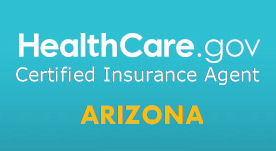Arizona health insurance
 Arizona
Health Exchange Buyers Guide
Arizona
Health Exchange Buyers GuideYour Buyer's Guide to the Arizona
Health Exchange!
 We're getting ready to go into our third year of the Affordable Care
Act (Obamacare) and, unfortunately, things show no signs of settling
down in the health insurance landscape.
We're getting ready to go into our third year of the Affordable Care
Act (Obamacare) and, unfortunately, things show no signs of settling
down in the health insurance landscape.
Some carriers are pulling out of various markets across the U.S.
(United Health Care, largest single carrier in the country being the
most prominent), rates will go up for some plans, and who knows what
will happen after the presidential election?
The Democrats want to "strengthen" Obamacare, while the Republicans
vow to destroy it.
So it behooves you to keep one eye on what's going on between now and
November 1st, when Open Enrollment begins again (during open enrollment
you have the option of signing up for the first time, or changing the
plan you now have).
How we got here
A quick recap of how things stand now.
In 2014 the Affordable Care Act went into effect, completely
revamping the health insurance, as it then stood. Whereas before the
players had basically been insurance companies and providers (doctors
and hospitals), a new component was introduced, the Exchanges, which
became the main focal point of getting insurance.
If a state didn't want to create its own exchange (and many did not),
it participated in the federal exchange.
There were differences among
the state and federal entities, but they all had the same goal: getting
as many people to sign up and be covered by the health care system as
possible.
An exchange provides an offering of plans that have to meet certain
government minimum requirements and have to offer specific benefits
before an insurance company can sell them.
What Makes the Arizona Exchange Different
The plans are either on-Exchange (typically offering some kind of tax
credit/subsidy based on a number of factors, the most important which
are income and family size) or off-Exchange which are almost identical,
but have no tax credit or subsidy.
What the federal government does is subsidize these plans to help
lower the monthly premium cost or provide a tax credit at the end of the
year.
The subsidy/tax credit is based on a rather complicated formula that
takes in a number of factors, including household income size, family
size, and the relation of one's income to the federal poverty level.
Subsidies can range from zero to several hundred dollars or more.
A major change with the Obamacare plans was that no one could be
denied based on medical underwriting.
Before there were several conditions such as being in remission for
cancer, multiple sclerosis or type one diabetes that would result in a
decline.
No more.
No matter what the precondition, guaranteed issue is a given.
Also, on individual/family plans, it was almost impossible to get
maternity coverage. Even if it were available, there were all kinds of
restrictions, including waiting periods and higher co-pays. Insurance
plans are now mandated to offer the coverage.
The Plans on The Exchange
The classification of plans haven't changed.
There are five tiers--catastrophic, bronze, silver, gold and
platinum---with different price points and range of benefits.
Basically the higher the plan--with platinum being at the top--the
lower the deductibles and the lower the copays. Conversely, premiums
will be higher.
A deductible is the amount you pay before the insurance pays
anything, and can vary between $1500 all the way up to $10,000. The
coinsurance is what you pay on the remainder of the bill once you have
paid the deductible, up to a cap. After you reach that cap, the
insurance company pays 100 percent of anything left over.
Plans with very high deductibles fall into the category of a
"catastrophic plan," meaning that you're going to have a major
catastrophic event before you repeat any benefit from the insurance.
The
higher the copay the less expensive the insurance premium since you're
going to be paying more before the insurance company has to pay
anything. (Typically copays run 80 percent, 70 percent or 50 percent,
with you being responsible for the remainder. By the way, true
catastrophic coverage is only available for individuals under the age of
30 or who meet certain hardship criteria.
The plans will pay benefits based on actuarial values. The insured
will pay the rest of the amount, based on predetermined deductibles,
co-insurance and co-pays.
Platinum plans will have an actuarial value of 90%, gold will have an
actuarial value of 80%, silver will have an actuarial value of 70% and
bronze will have an actuarial value of 60%.
Arizona Health Exchange Open Enrollment
Open enrollment, the date when anyone can apply or switch plans,
kicks off Nov. 1, 2016 and lasts through Jan. 31, 2017.
Applications submitted by December 15 will have a January 1, 2017,
effective date.
Applications submitted after December 15 will have a February 1st
effective date, and those submitted after Jan. 15th will have a March
1st effective date. (If the application is submitted between the
sixteenth and the last day of the month during open enrollment, the
coverage effective date assigned will be the first day of the second
following month).
How Much Do the Plans Cost?
Your premium amount is based on a number of factors, including where
your household income stands in relation to the federal poverty level
(FPL).
Federal poverty limits vary by family size.
The following table (2016
ranges; may change for 2017) illustrates the income that falls between
100% and 400% of FPL depending on family size.
| Family Size |
Income Between 100% and 400% FPL |
| Individual |
$10,830 to $43,336 |
| Family of 2 |
$14,470 to $58,280 |
| Family of 3 |
$18,310 to $73,240 |
| Family of 4 |
$22,050 to $88,200 |
Enhanced Silver Plans
Cost share reduction is another way to cut the cost of health
insurance for those who qualify for an on-exchange plan.
Some assistance in sharing the cost of the insurance will be offered
to those individuals who purchase health insurance through the exchange
and meet income levels between 100% to 250% of the federal poverty
level.
The individual must enroll in at least a silver plan in order to
qualify for cost share reduction, in addition to meeting the FPL
requirements.
Cost share reduction can result in a significant lowering of the cost
of the deductible and of copay amounts.
You can run your Arizona Health
Exchange Quote here
to view rates and plans side by side from the major carriers...Free.
Again, there is absolutely no
cost to you for our services. Call 866/471.8081 Today!
